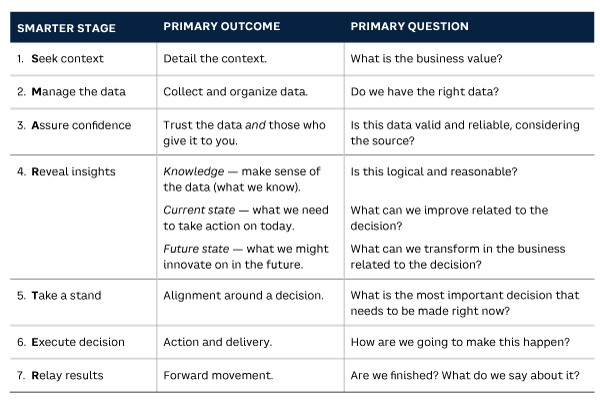Karen Dietz, PhD, and I designed Making SMARTERTM Decisions with Data, a collaborative data-informed decision-making approach to incorporate tangible business value, unknown and unknowable data, intuition, human emotions, actionable insights, and meaning-making. SMARTER stands for Seek context, Manage the data, Assure confidence, Reveal insights, Take a stand, Execute decision, and Relay results. The framework is particularly useful in uncertain, fast-changing, turbulent times — our business climate for the foreseeable future (see Figure 1).

Table 1 identifies the key outcome of each stage and the primary question being addressed. This framework does not presuppose in-depth training for employees and leaders on capturing/organizing data, addressing data quality, and analyzing and visualizing data, but experts with these skills must be available for collaboration. As staff and leaders become seasoned users of the SMARTER framework, they learn to hone these skills (outside of complex work that a data scientist or machine learning/artificial intelligence professional performs).

One might assume that high-risk, high-stakes decisions occur only in the strategic realm. However, in my 34 years of consulting, I have witnessed seemingly routine frontline team decisions involving work process performance, technology procurement, equipment maintenance, expense management, and the like, that had far-reaching implications. Thus, for the SMARTER methodology to consistently produce actionable results, it must be embedded into an organization’s DNA (i.e., culture, values) and used across all functions.
This is not how data strategy is currently framed. Organizations are encouraged to identify use cases aligned with business strategy and then to prioritize them for analytics work. Even though the SMARTER approach works well here, this method “projectizes” and compartmentalizes data-informed decision making. Then we wonder why leaders and staff are not routinely using data to improve decision making and why establishing a data culture is elusive.
Organizations are a bundle of three interconnected work processes/flows: daily work, cross-functional work, and strategic work. All processes have decisions attached to them, some simple (e.g., go/no go and if this, do that), others with higher risk (e.g., implementing the right marketing campaigns, selecting the right offerings for each customer segment) and decisions involving process standardization, continual improvement, problem solving, or innovation (e.g., fixing broken supply chains, accelerating new product development).
What if leaders and staff used the SMARTER approach to optimize these non-simple work process decisions, too? This would ensure alignment to both mission and vision enterprise-wide.
Acknowledgement: the author would like to acknowledge Karen Dietz, PhD, for her co-development of the Making SMARTERTM Decisions with Data framework.
[For more from the author on this topic, see: “Monetizing Data Through Informed, Collaborative Decision Making.”]
©2022 Lori Silverman. All rights reserved.



